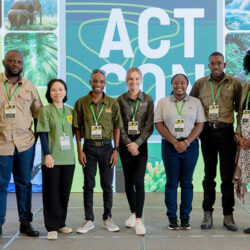Shrubs Gone Wild – CCF Investigates Bush Encroachment Control Methods
-

- by Brandy Morenko Campbell November 11, 2021

Article Summary of Restoration Thinning Reduces Bush Encroachment on Freehold Farmlands in Central Namibia
The open savannahs of southern Africa are slowly closing in. They are being overtaken by several species of woody and thorny bushes. In Namibia alone, approximately 45 million hectares of land are affected by bush encroachment. This phenomenon is caused by a variety of factors, including direct and indirect human impact on the environment. The loss of mega herbivores on the landscape, overgrazing, injudicious livestock stocking rates, poor soil and land management practices, as well as climate change are all changing the cheetah’s habitat and making it less suitable for thriving.
Land managers have used several techniques to combat this issue either alone or in combination. These methods include manual cutting of the shrubs with handheld tools, using small powered hand tools, using self-propelled cutting equipment, using domestic goats to browse, and using targeted biological or chemical arboricides. Cheetah Conservation Fund researchers in collaboration with the University of Eastern Finland and the Council for Scientific and Industrial Research – Ghana, recently evaluated the impacts of the thinning strategy applied on CCF farms to determine how effective it has been in reducing bush encroachment. The research evaluated these impacts on the soil and vegetation.


Two hundred and ninety-five (295) subplots, that included areas where manual bush thinning was utilized to reduce bush densities by 50%, were evaluated on three farms (Cheetah View, Boskop, Elandsvreugde). Researchers found that overall, thinning had minimal impacts towards the soils, areas that had undergone bush thinning had significantly higher total soil nitrogen levels possibly due to the high animal activity that led to dung/urine deposition and increased decomposition. Eventually, conditions in thinned areas could promote the swift growth of grasses for herbivores. Areas that had been thinned showed reduced abundance of shrubs without aftercare up to 7 years later and estimated calculations indicate that reduced levels could persist for up to 14 to 15 years. Treating stumps with arboricide was also found to influence the regrowth and natural regeneration of the shrubs. Thinning the encroaching bushes also led to selective regrowth of certain shrub species which could be of use in strategic land management practices.
This team was able to confirm that the selective thinning of bush encroached lands did reduce the abundance of encroaching shrubs for several years if done precisely. Most importantly, these managed areas do have the potential to encourage growth of open savannah habitat appropriate for grazing species that in turn supports hunting animals such as the cheetah, which requires open visibility and herbivore prey species. It is especially promising that these lands can be restored to support a more diverse and healthy ecosystem with hard work and persistence.

Related Reading
-
August 27, 2025
Sniffing Out Stories with the Scat Detection Dog Team




